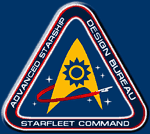 |
Design Flow |
 |
Design Flow |
| General | |||
| Home | About Us | Design Flow | Project List |
| Design Sketches | Dropped Designs | Fleet Charts | JoAT |
| Ship Classes | |||
| Andromeda | Antares | Bradbury | Deneva |
| Hokule'a | Istanbul | Korolev | Mediterranean |
| Merced | Renaissance | Sequoia | Surak |
| Wambundu | Yorkshire | ||
1. Collection of data from episodes or books. Any piece of information on the ship can be valuable in order to devise a suited design. For instance, registry numbers may reveal how old the design is. A crew count gives an impression of the ship's size. Finally, the ship's purpose may determine its look, for a freighter is expected to be less elegant than an explorer.
2. Design sketch. Such a sketch is supposed to give only a rough impression of how the ship could look like. You don't have to be a talented artist to draw such a sketch. In some cases a verbal description will do as well. The design sketch has to comply with several criteria resulting from the collected data, the most important of which is that the design has to fit in a certain era. This means that the ship should have similar design features as known ships from the same era. For instance, there were no visible escape pods or none at all on ships prior to 2300. The small phaser openings were extended to short strips by 2310 and to rings by 2340. It goes without saying that a ship of the early 24th century is not supposed to have advanced or even "exotic" technology such as bioneural circuits or quantum torpedoes.
3. More detailed design. Once the ASDB has agreed to the preliminary sketch, one of our artists (we are looking for some more volunteers!) is going to draw a more detailed schematic of the ship, and the specs are nailed down. The schematic should include details such as phaser strips, windows and lifeboats. The schematic should be drawn in a vector drawing program, so that changes are relatively easy.
4. Final design. The completed design should include a side, front and top view to give a complete impression of the ship's appearance. An MSD diagram is desirable as well. A 3D design is possible as a further option.
| Last modified: 28.03.13 |